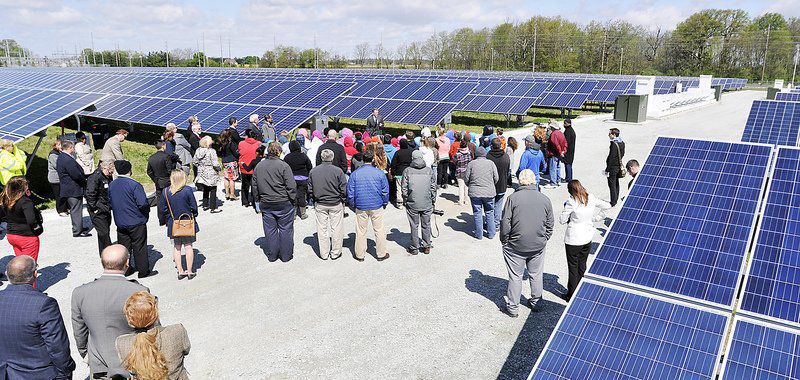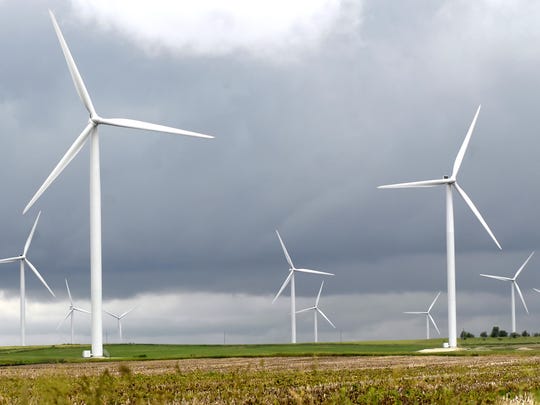Officially, wind turbines were not on the itinerary for Wednesday’s Henry County Commissioners meeting. But, as a unique one-hour public comment period and increased law enforcement presence proved, they continue to be on many minds.
Commissioner Ed Yanos excused himself from the extra commentary session, which was held after Wednesday’s regular meeting. Yanos is the county commissioners’ representative on the Henry County Planning Commission, which has received a wind farm permit application.
That left Commissioners President Kim Cronk – who facilitated the extra question-answer session in the first place – to field a barrage of accusations, pleas and complaints from many in the old Circuit Courtroom crowd of approximately 40 people. Commissioner Ed Tarantino was by his side literally, but didn’t hide the fact that he was on the side of protesters where the wind issue was concerned.
Perceived threats?
One of the biggest complaints of the evening concerned the larger than normal uniformed officers at the meeting.
“Why the overwhelming police presence here tonight?” Bobbi Plummer asked. “We have been painted for three years as these unruly, horrible people. It is just exhausting for us to be regarded in that way.”
Henry County Sheriff Ric McCorkle said an individual at the Middletown Fair “said we’d better be prepared.”
That individual, Middletown resident Ron Romine, expressed shock, disgust and dismay that his comments were regarded as a threat to anyone’s safety.
Romine said he meant “they’d better be prepared, because in the next election they’re going to be voted out.”
“I’m sorry for the misunderstanding,” Romine said.
“You have a right to freedom of speech and freedom of expression as long as it stays civil,” McCorkle said. “We are your sheriff’s department. We don’t take that information lightly. You know as well as I do in today’s world there are individuals out there who would take the opportunity to capitalize in a situation where they know the community is at odds with each other. There are individuals who would capitalize on that moment to cause a disturbance for that very reason, just to cause a disturbance.
“I would rather be overly prepared than to be having a separate conversation at a later date,” McCorkle concluded.
“I appreciate you being here. But that’s not what I meant,” Romine said,
Romine went on to say what, in his view, was an over-reaction to his comments is further proof of pressure coming down from pro-wind forces to make the turbines turn in Henry County.
“It’s pretty pathetic when you say something and somebody takes it the wrong way and eight cops show up,” Romine said. “That is the biggest and craziest thing I’ve ever heard of. Come to my house. You know where I live. Just come and talk to me. I love this county. That’s why we’re fighting for it. I don’t want to hurt anybody.”
Cronk thanked McCorkle and the other officers for their concerns and efforts at keeping order.
Cease and desist
Perhaps the most pointed – and poignant – moment of the evening came when Jim McShirley posed a question to Cronk. He asked if Henry County had a responsibility to support communities who had passed four-mile buffer zones. There were 13 of the 16 Henry County towns who did just that.
“That’s the decision the town boards made. We, the county, have our own ordinances,” Cronk said.
“Knowing that your towns, the very heart and soul of your communities, are against turbines being placed within four miles of their towns and knowing that Calpine is actively aggressively attempting to ignore that, why don’t you insist that Calpine cease and desist as this law stands, because your communities are more important than a giant corporation attempting to disregard law?” McShirley said.
Cronk said they were following regulations in county law and that the process should run its course.
“So these towns have to pathetically spend fortunes to defend their towns against their own county is what you’re saying,” McShirley said. “Does it make you feel good that all these citizens are pouring in money that they don’t have to defend their home towns and they are literally going broke fighting their county? Why can’t Calpine be told to stand down until this is ruled on and we have a better understanding of who is right?”
Then McShirley said, “Calpine is attempting to steamroll us.”
Time is of the essence
Time does appear to be of the essence for Calpine, which filed a formal application for Big Blue River Wind Farm earlier this month.
National reports say a production tax credit, established in 1994 and extended several times, is not likely to be renewed by the Trump Administration.
In his Oct. 8, 2018 news story “An Uncertain Future for America’s Wind Energy Capital,” co-published by The Center for Public Integrity and Mother Jones, reporter Kristian Hernández said this tax credit accounts for 70% of the $37 billion in subsidies the wind industry receives. Hernández said wind companies are scrambling to get in before a late 2019 deadline.
But with legal questions literally swirling in the wind, McShirley said it would be not only understandable, but appropriate for Commissioners to put the brakes on Calpine’s request until legal matters are settled.
“It would be powerful if the county – you – would just send Calpine a cease and desist letter,” McShirley told the commissioners.
“That’s what I would like to see happen,” Commissioner Tarantino said. “Until the court makes a ruling on that law, that we hold off giving commission approved use since it could be overturned at a later date. This project has been in the county for seven or eight years. This particular one is relatively new. I don’t see why we can’t – in view of the fact that the legislature grandfathered in, they did allow, not just Henry County but a few other counties who passed the four-mile rule. I don’t see why we can’t wait as far as the planning commission goes until the court makes a ruling.”
Applause then filled the courtroom.
“Why would we want a giant corporation to steamroll us and then find out later that they were wrong, but they’ve already got 38 turbines installed, so what can we do,” McShirley added. “That’s where it’s headed. Instead, the right thing to do is to let this play out in court, let this get settled and then move either way.”
McShirley pointed to the Cadiz power plant as a controversial local project citizens were powerless against.
“They didn’t even apply for a local permit. It got partially constructed and the ruling was, ‘well, they’re already 70% complete, we can’t make them tear it down,’” he said. “They got steamrolled. And that’s what’s going to happen again. I think the county is facilitating that.”
“Legally. Morally. Ethically.” McShirley used those words to say a cease and desist order was the right thing to do. “Instead we’re just facilitating this steamrolling.”
Cronk emphasized there would be a public hearing on the latest wind turbine request with the plan commission.
But there were cries of foul in the audience about the make-up of that commission and the fact that unelected people could determine an issue likely to affect a majority of Henry County residents.
“There are basically 22 family groups who will profit from turbines on their parcels and we have 50,000 people almost in the county,” said property owner Susie Eichhorn. “It is a fraction of a percent of the people who will stand to make an income from this compared to the county at large. I almost think it’s one acre, one vote. So if you don’t have any acreage, it sucks for you. It needs to stop. We’re at the 11th hour now and people are going to have their homes destroyed.
“Vern Sharrett’s house is surrounded,” Eichhorn continued. “I think he’ll see every turbine. All 38. Dan and Rosie Richey will see every turbine from their home. You are destroying people’s homes. The writing is on the wall. We need to stop it.”
Cronk adamantly defended himself and his family against allegations they were involved in the wind farm project in any way and vehemently objected to an accusation that county government was corrupt.
“Jay Cronk, my brother, was one of the first people to sign a petition against the turbines for Harrison Township. Nothing’s changed from my perspective,” the commissioner said.
Still, the anti-turbine forces pressed on, claiming that those who have the decision-making power either aren’t listening to the majority of local residents or don’t care what they think.
McShirley said the first hearing he counted every single person in the room and said there were 173 against wind and only seven in favor.
“Why do seven unelected people have the power to make this decision?” Judy Walker asked.
Only the beginning?
Henry County resident Don Miller also emphasized that the 38 turbines requested now may be only the beginning.
“When they first came to the county, they were looking at 80 to 100 (turbines). What do you know about phase two or phase three from Calpine? Is that a possibility?” Miller asked the commissioners.
“I have no idea,” Cronk said.
“I can say that is generally how it works,” Tarantino said. “When they pass a phase, they generally have more than one phase, two, three or four phases.





